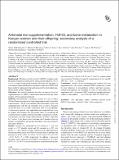| dc.contributor.author | Vickie S Braithwaite, Martin N Mwangi, Kerry S Jones, Ayşe Y Demir, Ann Prentice, Andrew M Prentice, Pauline E A Andang'o, Hans Verhoef | |
| dc.date.accessioned | 2021-07-15T08:29:25Z | |
| dc.date.available | 2021-07-15T08:29:25Z | |
| dc.date.issued | 2021 | |
| dc.identifier.uri | https://repository.maseno.ac.ke/handle/123456789/4164 | |
| dc.description.abstract | Background
Fibroblast growth factor-23 (FGF23) regulates body phosphate homeostasis primarily by increasing phosphaturia. It also acts as a vitamin D-regulating hormone. Maternal iron deficiency is associated with perturbed expression and/or regulation of FGF23 and hence might be implicated in the pathogenesis of hypophosphatemia-driven rickets in their offspring.
Objectives
We aimed to determine the effect of antenatal oral iron supplementation on FGF23 concentration and maternal and infant markers of bone-mineral regulation.
Methods
We performed a secondary analysis of a trial in which 470 rural Kenyan women with singleton pregnancies and hemoglobin concentrations ≥ 90 g/L were randomly allocated to daily, supervised supplementation with 60 mg elemental iron as ferrous fumarate or placebo from 13–23 weeks of gestation until 1 mo postpartum. As previously reported, iron supplementation improved iron status in mothers and neonates. For the present study, we reanalyzed all available plasma samples collected in mothers and neonates at birth, with primary outcomes being concentrations of FGF23, measured by 2 assays: 1 that detects intact hormone and C-terminal cleavage products (total-FGF23) and another that detects the intact hormone only (intact-FGF23).
Results
Analysis was performed on 433 women (n = 216, iron group; n = 217, placebo group) and 414 neonates (n = 207, iron group; n = 207, placebo group). Antenatal iron supplementation reduced geometric mean total-FGF23 concentrations in mothers and neonates by 62.6% (95% CI: 53.0%, 70.3%) and 15.2% (95% CI: −0.3%, 28.4%, P = 0.06), respectively. In addition, it increased geometric mean neonatal intact-FGF23 concentrations by 21.6% (95% CI: 1.2%, 46.1%), increased geometric mean maternal hepcidin concentrations by 136.4% (95% CI: 86.1%, 200.3%), and decreased mean maternal 25-hydroxyvitamin D concentrations by 6.1 nmol/L (95% CI: −11.0, −1.2 nmol/L).
Conclusions
Analysis of this randomized trial confirms that iron supplementation can reverse elevated FGF23 production caused by iron deficiency in iron-deficient mothers and their neonates. Further investigations are warranted to assess to what extent iron supplementation can prevent FGF23-mediated hypophosphatemic rickets or osteomalacia. | en_US |
| dc.publisher | The American Journal of Clinical Nutrition | en_US |
| dc.subject | iron deficiency anemia, fibroblast growth factor (FGF23), phosphate, vitamin D, bone, Africa, pregnancy | en_US |
| dc.title | Antenatal iron supplementation, FGF23, and bone metabolism in Kenyan women and their offspring: secondary analysis of a randomized controlled trial | en_US |
| dc.type | Article | en_US |

